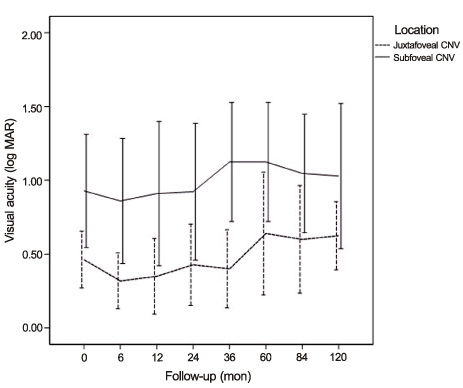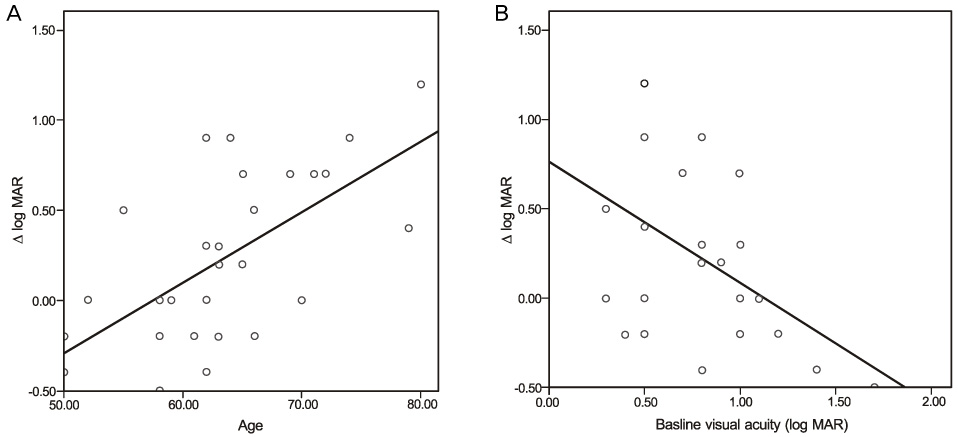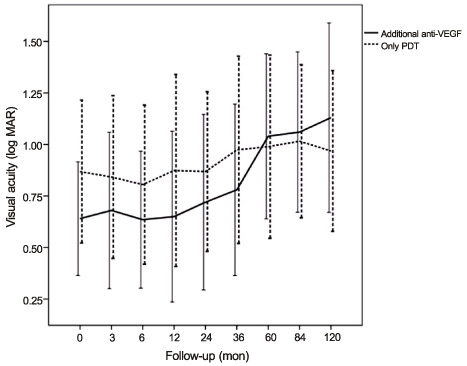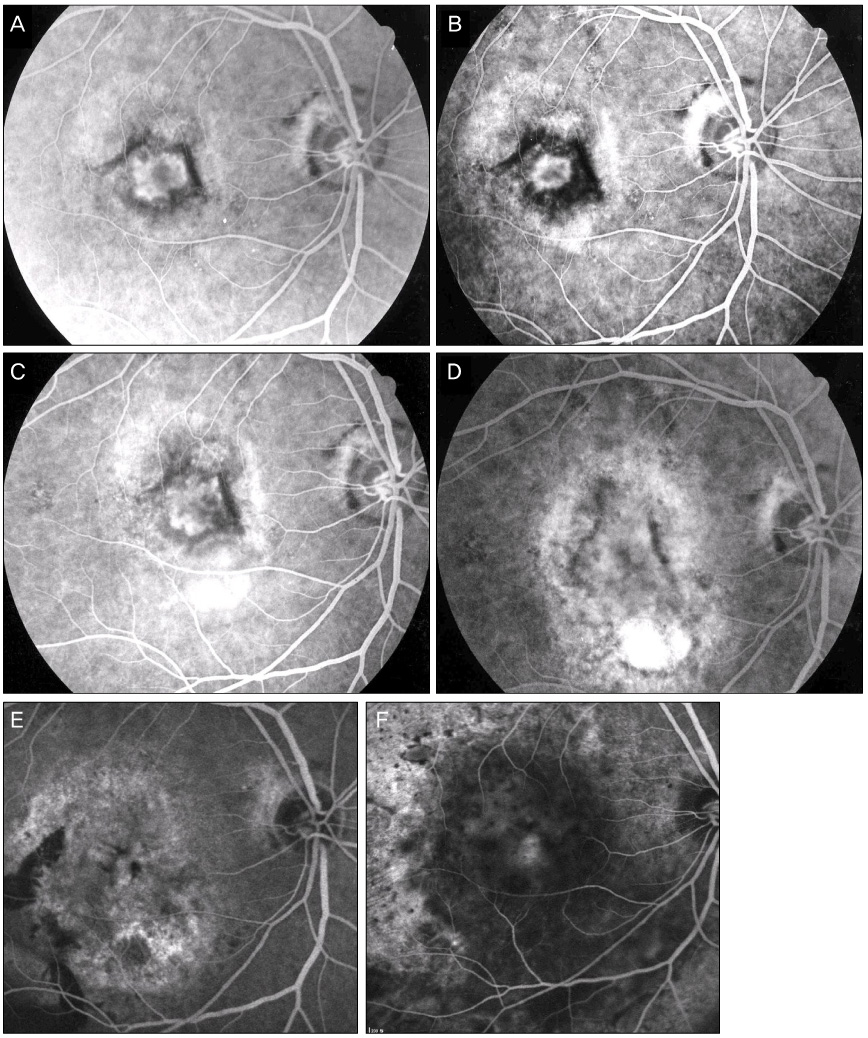J Korean Ophthalmol Soc.
2012 Jan;53(1):59-67. 10.3341/jkos.2012.53.1.59.
Photodynamic Therapy of Choroidal Neovascularization in Age-Related Macular Degeneration with Verteporfin: An Analysis of 10 Years of Clinical Results
- Affiliations
-
- 1Department of Ophthalmology, Kangnam Sacred Heart Hospital, Hallym University College of Medicine, Seoul, Korea. wooho.nam@gmail.com
- 2Department of Ophthalmology, Hangang Sacred Heart Hospital, Hallym University College of Medicine, Seoul, Korea.
- KMID: 2215246
- DOI: http://doi.org/10.3341/jkos.2012.53.1.59
Abstract
- PURPOSE
To analyze the long-term results of photodynamic therapy (PDT) for exudative age-related macular degeneration (AMD).
METHODS
The clinical data of patients treated with photodynamic therapy for exudative age-related macular degeneration between April 2000 and December 2000 were analyzed. Patients were followed-up for at least 10 years after PDT.
RESULTS
Twenty-nine eyes of 29 patients were enrolled. Mean visual acuity on the logarithm of the minimum angle of resolution (log MAR) scale was 0.78 +/- 0.34 at baseline, 1.01 +/- 0.42 at 60 months, and 1.02 +/- 0.41 at 120 months. Predominantly classic, minimally classic, and occult without classic choroidal neovascularization was noted in 51.7%, 17.2%, and 31.1% of patients, respectively. Visual acuity was improved by 1 or more lines in 27.6% of patients and was unchanged in 20.7% of patients, while 51.7% of patients had lost 1 or more lines of visual acuity by 120 months. Baseline visual acuity and age were associated with the final visual prognosis (p < 0.05). Four patients developed neovascular AMD in the contralateral eye.
CONCLUSIONS
PDT is safe and effective for neovascular AMD. However, AMD can recur at any time and thus patients should be followed-up for a long period of time.
Keyword
MeSH Terms
Figure
Reference
-
1. Friedman DS, O'Colmain BJ, Muñoz B, et al. Prevalence of age-related macular degeneration in the United States. Arch Ophthalmol. 2004. 122:564–572.2. Klein R, Klein BE, Linton KL. Prevalence of age-related maculopathy. The Beaver Dam Eye Study. Ophthalmology. 1992. 99:933–943.3. Vingerling JR, Dielemans I, Hofman A, et al. The prevalence of age-related maculopathy in the Rotterdam Study. Ophthalmology. 1995. 102:205–210.4. Ferris FL 3rd, Fine SL, Hyman L. Age-related macular degeneration and blindness due to neovascular maculopathy. Arch Ophthalmol. 1984. 102:1640–1642.5. Bressler SB, Bressler NM, Fine SL, et al. Natural course of choroidal neovascular membranes within the foveal avascular zone in senile macular degeneration. Am J Ophthalmol. 1982. 93:157–163.6. Bressler NM, Bressler SB, Fine SL. Age-related macular degeneration. Surv Ophthalmol. 1988. 32:375–413.7. Guyer DR, Fine SL, Maguire MG, et al. Subfoveal choroidal neovascular membranes in age-related macular degeneration. Visual prognosis in eyes with relatively good initial visual acuity. Arch Ophthalmol. 1986. 104:702–705.8. Macular Photocoagulation Study Group. Laser photocoagulation of subfoveal neovascular lesions in age-related macular degeneration. Results of a randomized clinical trial. Arch Ophthlamol. 1991. 109:1220–1231.9. Emerson MV, Lauer AK, Flaxel CJ, et al. Intravitreal bevacizumab (Avastin) treatment of neovascular age-related macular degeneration. Retina. 2007. 27:439–444.10. Kaiser PK. Treatment of Age-related Macular Degeneration with Photodynamic Therapy (TAP) Study Group. Verteporfin therapy of subfoveal choroidal neovascularization in age-related macular degeneration: 5-year results of two randomized clinical trials with an open-label extension : TAP report No. 8. Graefes Arch Clin Exp Ophthalmol. 2006. 244:1132–1142.11. Japanese Age-Related Macular Degeneration Tial (JAT) Study Group. Japanese age-related macular degeneration trial: 1-year results of photodynamic therapy with verteporfin in Japanese patients with subfoveal choroidal neovascularization secondary to age-related macular degeneration. Am J Ophthalmol. 2003. 136:1049–1061.12. Schmidt-Erfurth U, Hasan T, Gragoudas E, et al. Vascular targeting in photodynamic occlusion of subretinal vessels. Ophthalmology. 1994. 101:1953–1961.13. Miller JW, Walsh AW, Kramer M, et al. Photodynamic therapy of experimental choroidal neovascularization using lipoprotein-delivered benzoporphyrin. Arch Ophthalmol. 1995. 113:810–818.14. Kramer M, Miller JW, Michaud N, et al. Liposomal benzoporphyrin derivative verteporfin photodynamic therapy. Selective treatment of choroidal neovascularization in monkeys. Ophthalmology. 1996. 103:427–438.15. Haimovici R, Kramer M, Miller JW, et al. Localization of lipoprotein-delivered benzoporphyrin derivative in the rabbit eye. Curr Eye Res. 1997. 16:83–90.16. Schmidt-Erfurth U, Flotte TJ, Gragoudas ES, et al. Benzoporphyrin-lipoprotein-mediated photodestruction of intraocular tumors. Exp Eye Res. 1996. 62:1–10.17. Miller H, Miller B. Photodynamic therapy of subretinal neovascularization in the monkey eye. Arch Ophthalmol. 1993. 111:855–860.18. Mataix J, Desco MC, Palacios E, et al. Photodynamic therapy for age-related macular degeneration treatment: epidemiological and clinical analysis of a long-term study. Ophthalmic Surg Lasers Imaging. 2009. 40:277–284.19. Yu HG, Kang SW, Nam WH, et al. Photodynamic therapy for choroidal neovascularization secondary to age-related macular degeneration. J Korean Ophthalmol Soc. 2007. 48:789–798.20. Hijikata K, Masuda K. Visual prognosis in Behet’s disease: effects of cyclophosphamide and colchicine. Jpn J Ophthalmol. 1978. 22:506–519.21. Kaiser PK, Boyer DS, Garcia R. Registry of Visudyne AMD Therapy Writing Committee. Verteporfin photodynamic therapy combined with intravitreal bevacizumab for neovascular age-related macular degeneration. Ophthalmology. 2009. 116:747–755.22. Kim JW, Kim HK, Kim HC. Photodynamic therapy for choroidal neovascularization caused by age-related macular degeneration (AMD). J Korean Ophthalmol Soc. 2002. 43:1435–1443.23. Lee DW, Kwon OU. Photodynamic therapy of subfoveal choroidal neovascularization-interval and number of application of verteporfin treatment. J Korean Ophthalmol Soc. 2004. 45:736–743.24. Park KH, Song SJ, Lee WK, et al. The results of nation-wide registry of age-related macular degeneration in Korea. J Korean Ophthalmol Soc. 2010. 51:516–523.25. Bressler NM. Treatment of Age-related Macular Degeneration with Photodynamic Therapy (TAP) Study Group. Photodynamic therapy of subfoveal choroidal neovascularization in age-related macular degeneration with verteporfin: two-year results of 2 randomized clinical trials-TAP report 2. Arch Ophthalmol. 2001. 119:198–207.26. Ruiz-Moreno JM, Montero JA, Arias L, et al. Photodynamic therapy in subfoveal and juxtafoveal idiopathic and postinflammatory choroidal neovascularization. Acta Ophthalmol Scand. 2006. 84:743–748.27. Wachtlin J, Stroux A, Wehner A, et al. Photodynamic therapy with verteporfin for choroidal neovascularisations in clinical routine outside the TAP study. One- and two-year results including juxta-foveal and extrafoveal CNV. Graefes Arch Clin Exp Ophthalmol. 2005. 243:438–445.28. Bressler SB, Pieramici DJ, Koester JM, Bressler NM. Natural history of minimally classic subfoveal choroidal neovascular lesions in the treatment of age-related macular degeneration with photodynamic therapy (TAP) investigation: outcomes potentially relevant to management--TAP report No. 6. Arch Ophthalmol. 2004. 122:325–329.29. Verteporfin In Photodynamic Therapy Study Group. Verteporfin therapy of subfoveal choroidal neovascularization in age-related macular degeneration: two-year results of a randomized clinical trial including lesions with occult with no classic choroidal neovascularization--verteporfin in photodynamic therapy report 2. Am J Ophthalmol. 2001. 131:541–560.30. Bressler NM, Arnold J, Benchaboune M, et al. Verteporfin therapy of subfoveal choroidal neovascularization in patients with age-related macular degeneration: additional information regarding baseline lesion composition's impact on vision outcome--TAP report No. 3. Arch Ophthalmol. 2002. 120:1443–1454.31. Rosenfeld PJ, Brown DM, Heier JS, et al. MARINA Study Group. Ranibizumab for neovascular age-related macular degeneration. N Engl J Med. 2006. 355:1419–1431.32. Brown DM, Kaiser PK, Michels M, et al. ANCHOR Study Group. Ranibizumab versus verteporfin for neovascular age-related macular degeneration. N Engl J Med. 2006. 355:1432–1444.33. Wong TY, Chakravarthy U, Klein R, et al. The natural history and prognosis of neovascular age-related macular degeneration: a systematic review of the literature and meta-analysis. Ophthalmology. 2008. 115:116–126.
- Full Text Links
- Actions
-
Cited
- CITED
-
- Close
- Share
- Similar articles
-
- Effect of Photodynamic Therapy and Intravitreal Triamcinolone Acetonide on Choroidal Neovascularization in Age-related Macular Degeneration
- Combined Photodynamic Therapy and Intravitreal Bevacizumab Injection for Exudative Age-Related Macular Degeneration and Polypoidal Choroidal Vasculopathy
- Photodynamic Therapy of Choroidal Neovasculariation Associated with Large Serous Pigment Epithelial Detachment
- Photodynamic Therapy with Verteporfin for Subfoveal Choroidal Neovascularization in Vogt-Koyanagi-Harada Syndrome
- Photodynamic Therapy of Subfoveal Choroidal Neovascularization-Interval and Number of Application of Verteporfin Treatment






